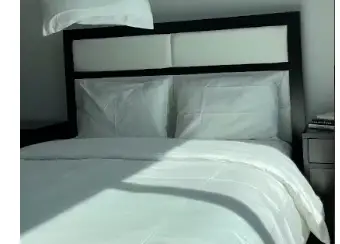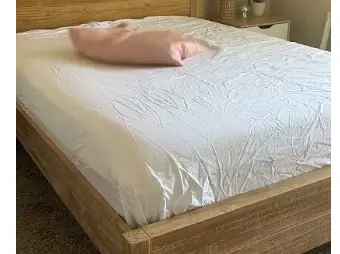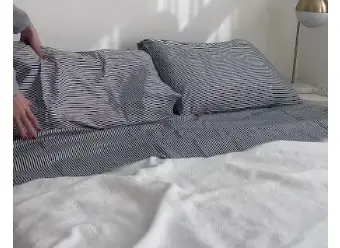I’ve always wondered why some bedding feels like a splurge, and Brooklinen’s luxurious sheets caught my eye with their premium price tags. As someone who loves a cozy bed, I wanted to understand what makes Brooklinen so costly. In this article, I’ll explore the reasons behind their high prices, from top-notch materials to ethical production, in a way that’s clear and engaging. My goal is to help you decide if Brooklinen’s bedding is worth your investment, breaking down the factors that drive its cost while sharing my own experience with their products.
Key Reasons Behind Brooklinen’s High Price
Here’s what makes Brooklinen bedding a premium purchase:
- High-Quality Materials
- Superior Manufacturing Processes
- Niche Market Positioning
- Stringent Quality Control
- Brand Legacy and Consumer Loyalty
- Limited Availability and High Demand
- Thoughtful Packaging and Aesthetic Appeal
- Environmental and Ethical Commitments
Also read:My Final Thoughts Sijo Vs. Brooklinen Sheets
High-Quality Materials
When I first slipped into Brooklinen’s Luxe Sateen sheets, I was hooked on their buttery-soft texture. That luxurious feel comes from their use of long-staple cotton, a premium material that’s a cut above standard cotton. Long-staple cotton, often sourced from regions like Egypt or India, has longer fibers that create smoother, more durable fabrics. Unlike the short-staple cotton used in budget bedding, which pills and wears out quickly, Brooklinen’s cotton resists fraying and feels softer over time. This quality doesn’t come cheap—long-staple cotton is pricier to grow and process due to its limited yield and careful harvesting.
Brooklinen also offers variety, with six sheet types: percale, sateen, linen, organic cotton, flannel, and heathered cashmere. Each material is chosen for its unique properties, like percale’s crisp breathability or linen’s airy texture, perfect for hot sleepers like me. Linen, for instance, is made from flax, a crop that’s costly to cultivate and weave due to its labor-intensive process. The heathered cashmere sheets, a newer addition, are even more expensive because cashmere is a rare, high-end fiber. These material choices explain why a Brooklinen sheet set can cost $150–$300, compared to $30–$50 for generic brands.
The attention to detail extends to thread count. Brooklinen’s Luxe Sateen boasts a 480-thread-count weave, striking a balance between softness and durability. Higher thread counts require more material and precise weaving, increasing costs. I’ve noticed that their sheets feel substantial yet breathable, unlike cheaper high-thread-count options that feel heavy or trap heat. This focus on premium materials sets Brooklinen apart but drives up the price significantly.
Superior Manufacturing Processes

I was curious about what goes into making Brooklinen’s bedding, so I looked into their production. The brand partners with small-scale factories, often family-owned, in countries like Portugal and India, known for their textile expertise.
These facilities use advanced weaving techniques to create fabrics that are both durable and luxurious. Unlike mass-produced bedding from large factories, Brooklinen’s smaller-scale production allows for greater precision but comes with higher costs due to limited output and specialized labor.
The manufacturing process also involves multiple steps to ensure quality. For example, Brooklinen’s cotton is combed to remove impurities, resulting in a smoother finish. Their linen sheets undergo stone-washing for that lived-in softness I love, a process that requires extra time and resources. These techniques aren’t just about aesthetics—they enhance durability, so my sheets still look great after years of use. However, this level of craftsmanship means higher labor and production costs, which are reflected in the price tag.
Brooklinen’s direct-to-consumer model cuts out middlemen, which should lower costs, but the savings are reinvested into quality. Unlike traditional retailers with bloated markups, Brooklinen focuses on delivering premium products at a slightly lower premium than luxury competitors like Frette. Still, their manufacturing choices make a queen-size Luxe Sateen set pricier than big-box store alternatives.
Niche Market Positioning
Brooklinen’s branding screams “luxury for the modern millennial,” and I’m totally their target audience. Launched in 2014, the brand carved out a niche by offering high-end bedding without the department store markup. They cater to people like me who want hotel-quality sheets but don’t want to pay $500+ for them. This niche positioning allows Brooklinen to charge more than mass-market brands like Target’s Threshold line but less than ultra-luxury names.
Their marketing is spot-on, emphasizing a curated, lifestyle-driven experience. From their sleek website to their Instagram-worthy aesthetic, Brooklinen sells a vibe—think cozy mornings with coffee and a good book. This resonates with younger buyers who value quality and style over quantity. I’ve noticed their limited-edition collections, like seasonal colors or patterns, create a sense of exclusivity, encouraging fans to splurge. However, this niche focus means smaller production runs, which don’t benefit from the cost savings of mass production, keeping prices high.
Brooklinen’s direct-to-consumer approach also means they control the customer experience, from purchase to delivery. This hands-on strategy requires investment in customer service and logistics, which adds to costs. For me, the personalized feel of shopping with Brooklinen makes the price feel justified, but it’s a key reason they’re not competing with budget brands.
Stringent Quality Control
I’ve never had a Brooklinen product arrive with loose threads or uneven stitching, and that’s no accident. The brand works with top-tier inspectors to ensure every sheet, duvet, or towel meets strict standards. Their quality control involves multiple checks, from raw material testing to finished product inspections, ensuring consistency across batches. This meticulous process catches defects early, so what I get is flawless, but it’s not cheap to maintain.
For example, Brooklinen tests for colorfastness, shrinkage, and durability, ensuring their sheets hold up through countless washes. I’ve washed my percale sheets dozens of times, and they still feel crisp and look vibrant. These tests require specialized equipment and skilled inspectors, adding to production costs. Unlike budget brands that might skip rigorous testing to cut corners, Brooklinen’s commitment to quality means higher overhead, which is passed on to consumers.
Their warranty program also reflects this focus. If my sheets develop issues like pilling within a year, Brooklinen offers replacements, which is great but costly for them. This assurance adds value but contributes to the premium price, as they factor in potential returns and replacements.
Brand Legacy And Consumer Loyalty
Brooklinen’s only been around for a decade, but they’ve built a loyal following that rivals older luxury brands. I’ve seen fans on Reddit rave about their sheets, even if some complain about stretching over time. This loyalty stems from Brooklinen’s consistent quality and relatable branding. As someone who’s bought multiple sets, I feel like part of their community, which keeps me coming back despite the cost.
Their legacy is tied to innovation—pioneering the direct-to-consumer bedding boom. Founders Rich and Vicki Fulop started with a Kickstarter campaign, focusing on quality and affordability relative to luxury brands. This origin story resonates with customers, creating an emotional connection. I love knowing my purchase supports a brand that started small and prioritizes quality.
Maintaining this legacy requires investment in marketing, customer engagement, and consistent product excellence. Brooklinen’s collaborations with artists for limited-edition designs or their expansion into towels and loungewear show they’re not resting on their laurels. These efforts build loyalty but increase costs, which is why a set of their sheets costs more than a generic alternative.
Limited Availability And High Demand

One thing that frustrates me about Brooklinen is how their best items, like limited-edition colors, sell out quickly. This scarcity isn’t just bad luck—it’s part of their strategy. By producing smaller batches, Brooklinen maintains exclusivity, driving demand and justifying higher prices. Unlike mass-market brands that flood stores with inventory, Brooklinen’s controlled supply creates a sense of urgency. I’ve rushed to buy a set of their Washed Linen sheets before they sold out, and that FOMO is real.
High demand also stems from their reputation. Reviews on sites like Business Insider praise their quality, boosting their popularity. When supply can’t keep up, prices stay high. For example, a queen-size linen sheet set can cost $250+, partly because of this dynamic. Brooklinen’s direct-to-consumer model means they don’t overstock, which keeps their brand premium but makes their products pricier than widely available alternatives.
Also read:My Final Thoughts Grab Red Land Cotton Sheets
Thoughtful Packaging And Aesthetic Appeal
Unboxing my Brooklinen sheets felt like opening a gift. The sleek, minimalist packaging, complete with a reusable cotton bag, adds to the luxury experience. But that thoughtful design comes at a cost. High-quality packaging materials, like sturdy boxes and eco-friendly bags, are more expensive than the plastic wraps used by budget brands. Brooklinen’s attention to detail, like custom-printed boxes that align with their aesthetic, adds to production costs.
The sheets themselves are designed with style in mind. Features like envelope closures on pillowcases or labeled “long” and “short” sides on fitted sheets make them user-friendly and elegant. I love how these touches make my bed look polished, but creating these details requires extra manufacturing steps. The aesthetic appeal extends to their color palette—think muted neutrals and trendy hues like terracotta—that appeals to design-conscious buyers. Developing and maintaining this cohesive look isn’t cheap, contributing to the overall price.
Environmental And Ethical Commitments
As someone who tries to shop sustainably, I appreciate Brooklinen’s efforts to be eco-conscious. They use some lower-impact materials, like organic cotton for certain collections, which is grown without harmful pesticides. Organic cotton is pricier due to stricter farming regulations and lower yields. Their linen sheets, made from flax, are also more sustainable than synthetic fabrics, but flax production is labor-intensive and costly.
Brooklinen’s warranty program keeps products out of landfills by offering repairs or replacements for defective items. They also partner with factories that adhere to ethical labor standards, ensuring fair wages and safe working conditions. These commitments resonate with me, but they increase costs. Certifications for organic materials or ethical production often require third-party audits, adding to expenses. While I love that Brooklinen aligns with my values, these efforts are a big reason their bedding costs more than conventional options.
Comparing Brooklinen To Alternatives

To put Brooklinen’s price in perspective, I compared it to other brands. Budget options like Target’s Threshold sheets cost $30–$50 for a queen set but use lower-quality cotton that pills quickly. High-end brands like Frette or Boll & Branch can charge $500+ for similar materials, making Brooklinen’s $150–$300 range a middle ground. I’ve tried Boll & Branch, and while their organic cotton is comparable, Brooklinen’s softer weave and modern aesthetic win me over.
Parachute, another direct-to-consumer brand, offers similar pricing but focuses more on linen and earthy tones. Brooklinen’s wider variety—percale, sateen, cashmere—gives it an edge for versatility. For me, Brooklinen’s balance of quality, style, and accessibility justifies the cost, but budget shoppers might prefer cheaper alternatives if luxury isn’t a priority.
The Value Proposition
So, is Brooklinen worth the splurge? For me, the answer hinges on what you value. If you prioritize softness, durability, and a stylish bedroom, Brooklinen’s sheets are a solid investment. Their long-staple cotton and thoughtful design mean I’m still loving my sheets years later, unlike cheaper sets I’ve replaced annually. The eco-friendly and ethical practices add peace of mind, though they bump up the price.
However, if you’re just looking for functional bedding, you might not need Brooklinen’s premium features. I’ve found that their sheets save me money in the long run because they last longer, but the upfront cost can feel steep. Ultimately, it’s about whether the luxury and longevity align with your budget and lifestyle.
Frequently Asked Questions
Yes, if you value soft, durable, and stylish bedding. Their long-staple cotton and ethical production justify the cost, but budget options work for basic needs.
No, Brooklinen sheets are primarily made in Portugal and India, with some products sourced from other countries, depending on the material and collection.
With proper care, Brooklinen sheets can last 3–5 years. Replace them if they show signs of pilling, thinning, or fading, depending on usage.
Many Brooklinen sheets, like their Luxe Sateen and Classic Percale, are 100% long-staple cotton. Others, like linen or cashmere, use different premium fibers.
Conclusion
You’re probably wondering if Brooklinen’s high price tag is worth it. I’ve explored the factors behind their cost, from long-staple cotton and ethical production to niche branding and limited availability.
For me, the softness, durability, and modern aesthetic make Brooklinen a standout, but it’s up to you to decide if those qualities justify the investment. Whether you’re a bedding enthusiast or just want a cozy night’s sleep, understanding these reasons can help you choose wisely.
Hopefully, this breakdown sheds light on why Brooklinen costs what it does and whether it’s the right fit for your bedroom.
